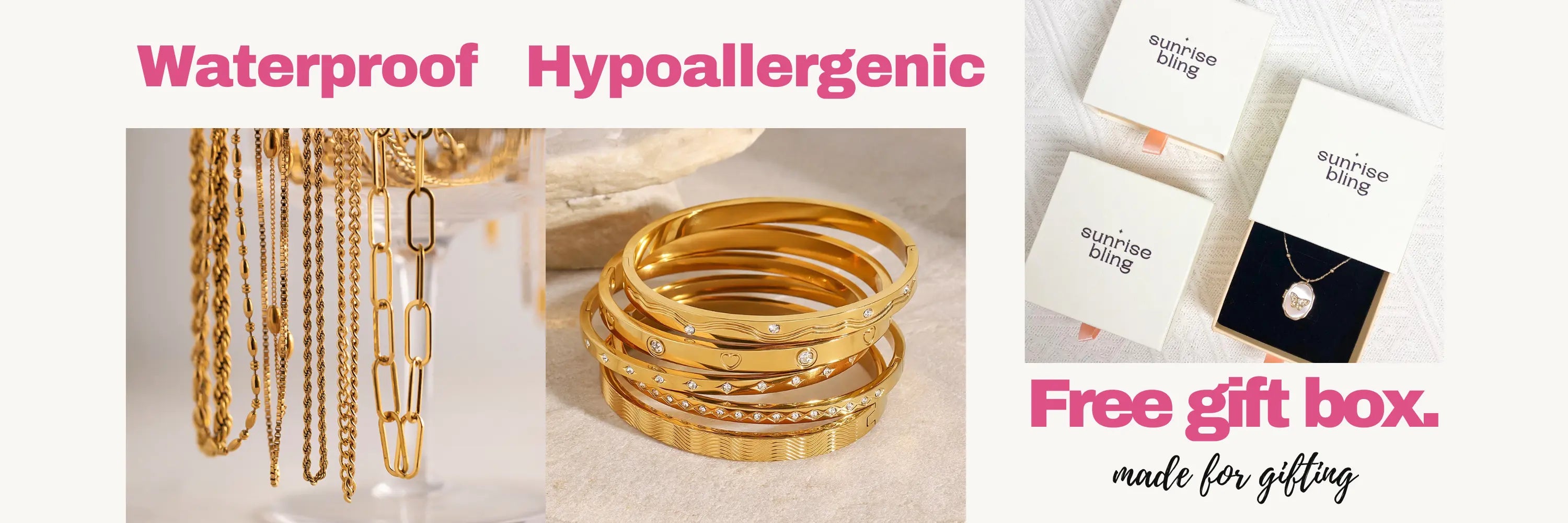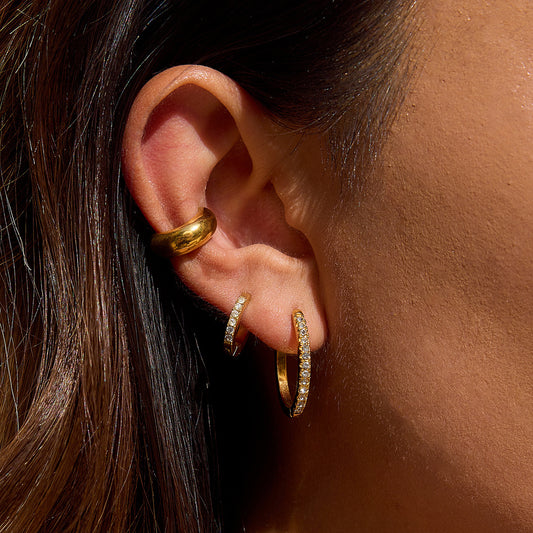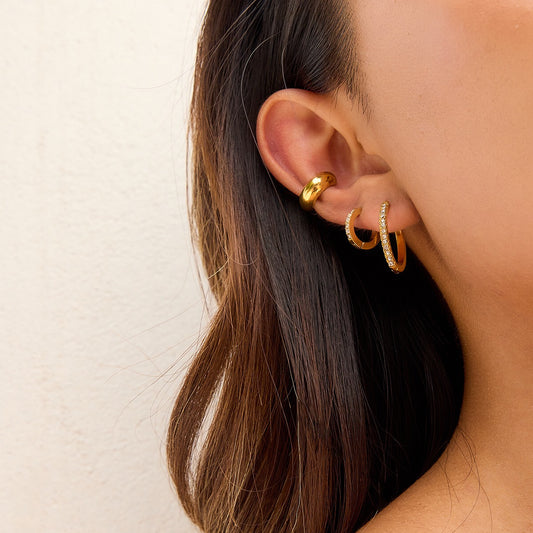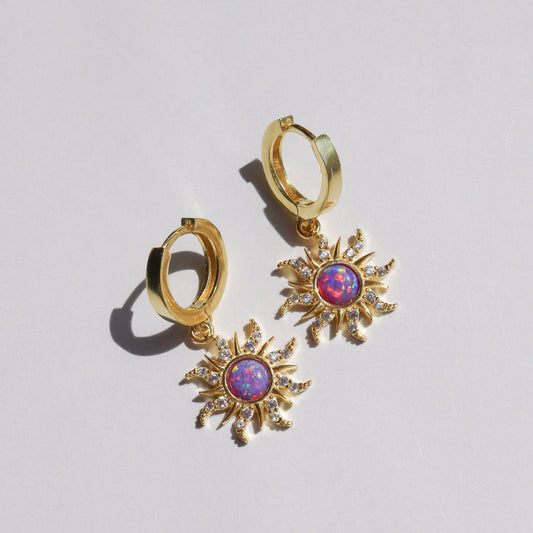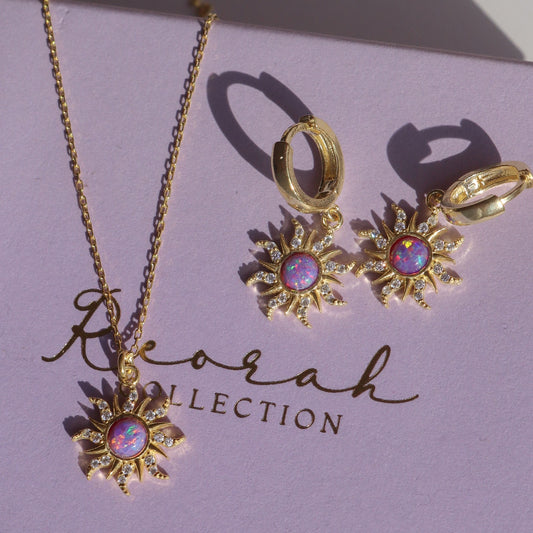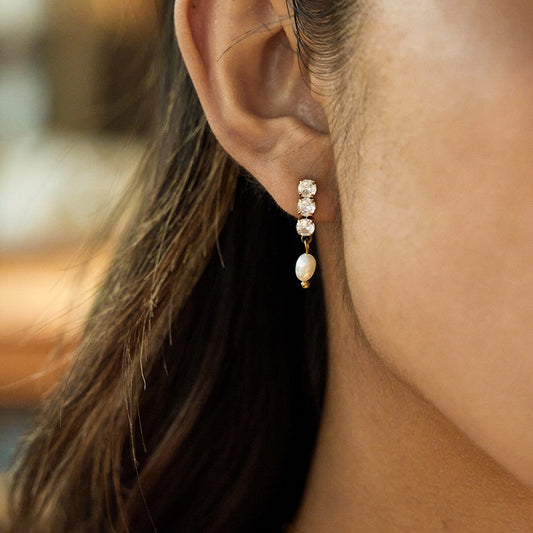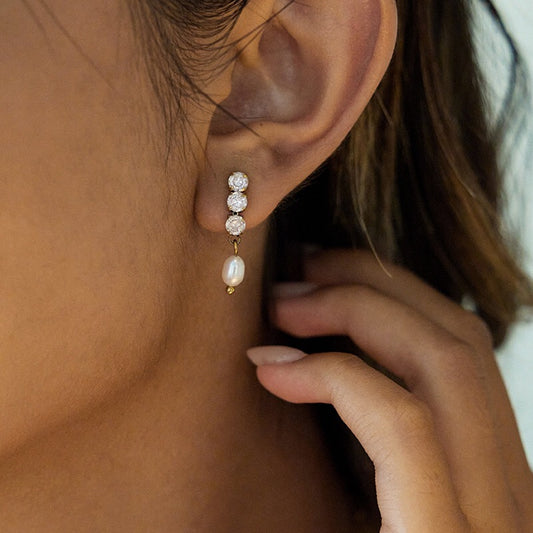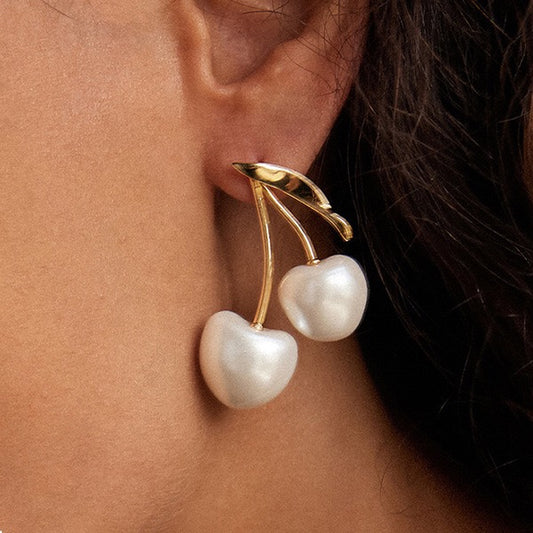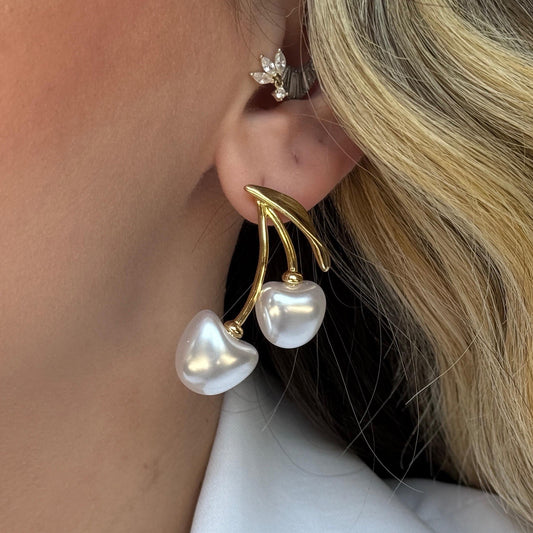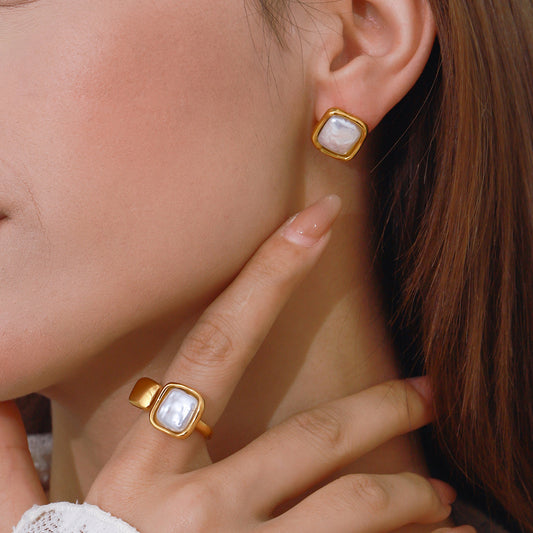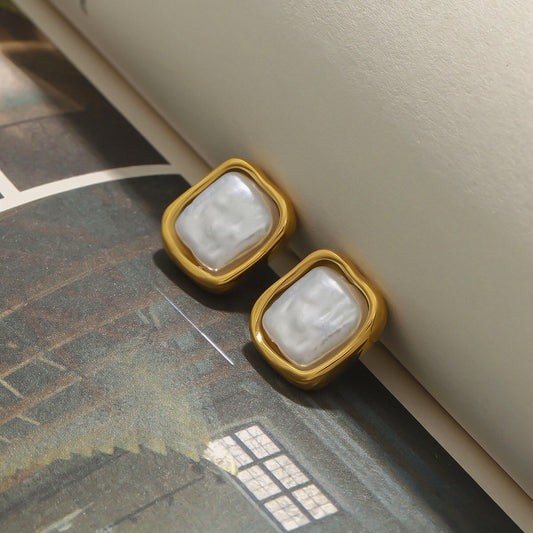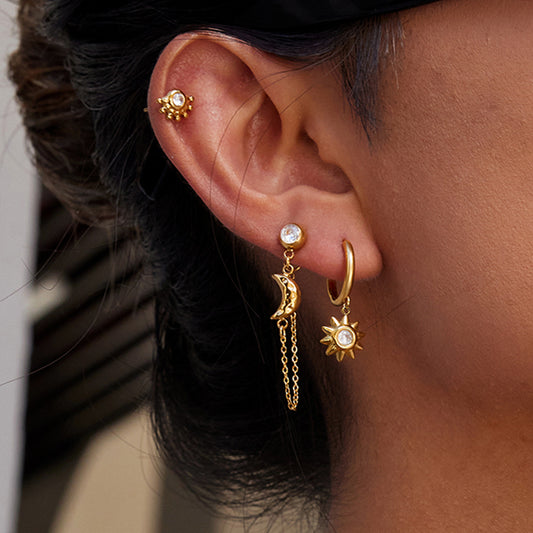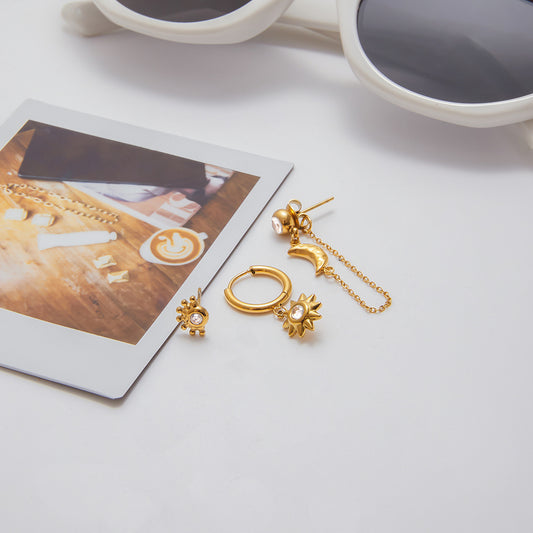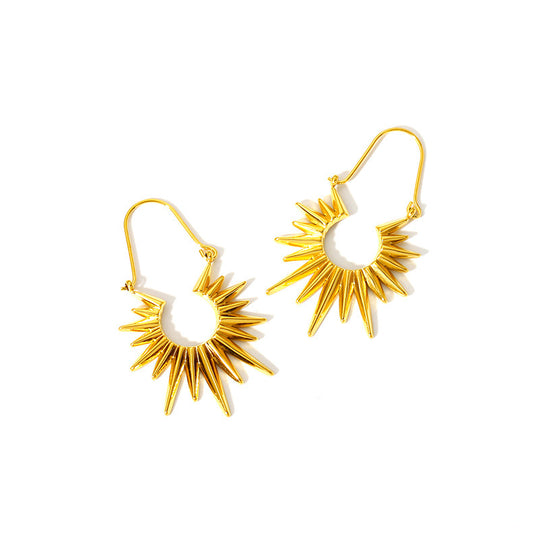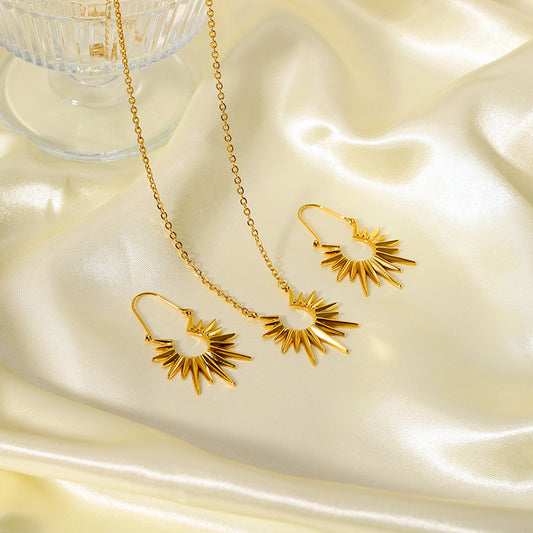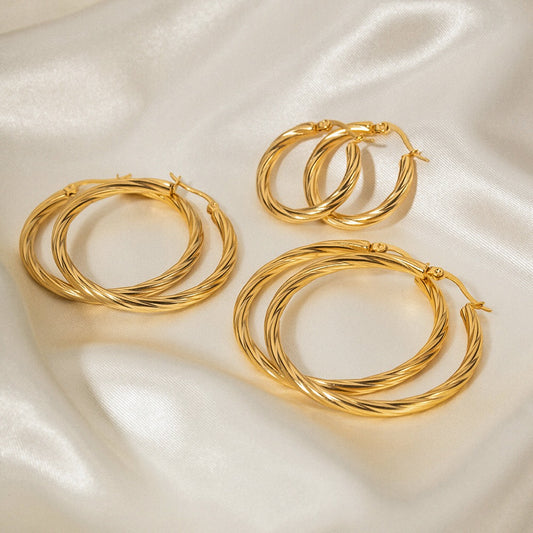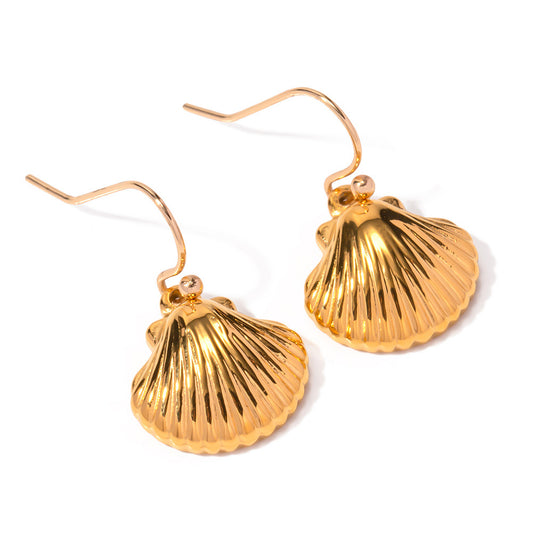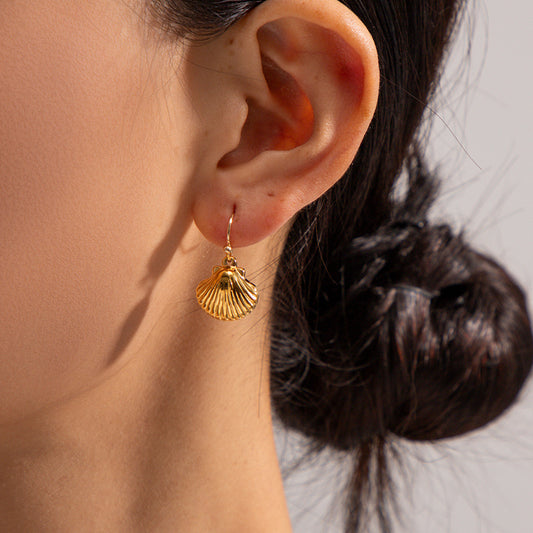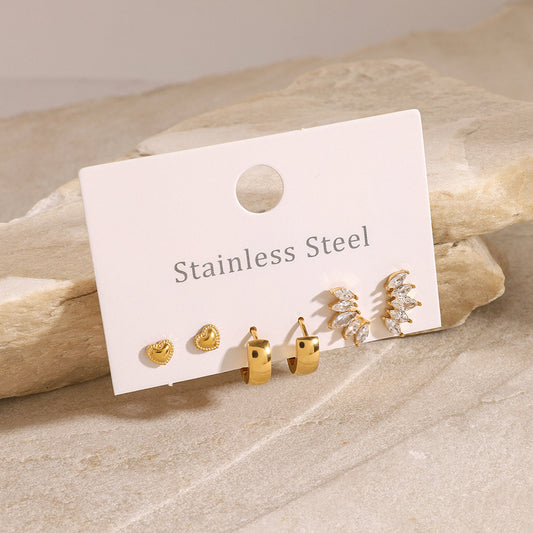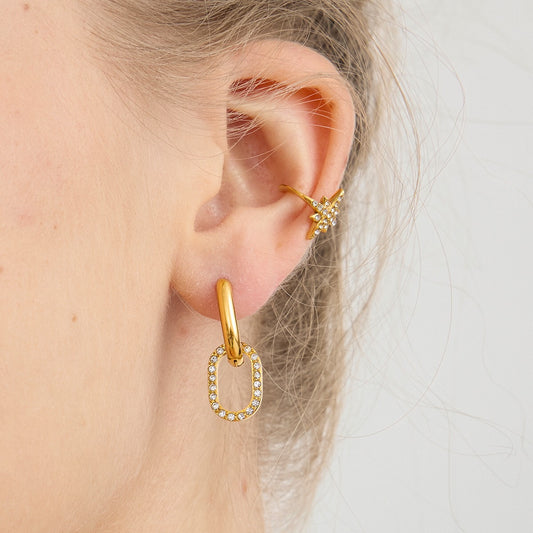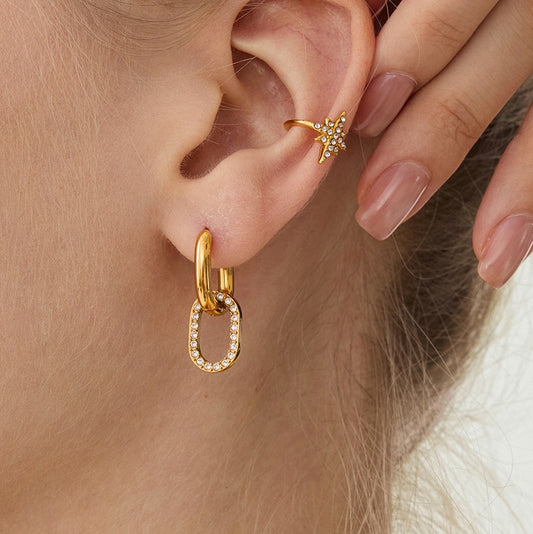Earring backs are the unsung heroes of jewelry—they keep your favorite earrings in place, prevent loss, and make all-day wear comfortable. Yet most people overlook them until they’re dealing with a lost stud, a sore earlobe, or a back that won’t stay put. The global costume jewelry market size is projected to reach from USD 51.05 billion in 2025 to USD 91.73 billion by 2033, growing at a CAGR of 7.6%. Whether you’re wearing delicate diamond studs, bold hoops, or heavy drop earrings, the right earring back can turn a frustrating accessory into a worry-free staple. This guide breaks down everything you need to know about earring backs: types, how to choose them, and how to keep your earrings secure.

What Are Earring Backs?
Earring backs (also called "earring clutches" or "earring stoppers") are small components that attach to the post of an earring to hold it in place on your earlobe. While they may seem like an afterthought, their design directly impacts comfort, security, and whether you’ll keep (or lose) your earrings. To understand their importance, let’s explore their core purpose and what makes a good earring back.
Core Purpose of Earring Backs
A high-quality earring back serves three critical roles:
-
Security: Prevents earrings from slipping off your earlobe (the #1 job—no one wants to lose a favorite pair!).
-
Comfort: Sits flush against your skin without digging, pinching, or causing irritation—even during all-day wear.
-
Stability: Holds earrings (especially heavy ones like drop or chandelier styles) upright, so they don’t tilt or sag.
Key Traits of a Good Earring Back
Not all earring backs are created equal—look for these features to avoid frustration:
-
Secure Grip: It should stay tight on the earring post, even with movement (no wiggling or slipping).
-
Smooth Edges: No sharp or rough parts that can scratch your skin or catch on hair/clothing.
-
Durable Material: Resists tarnish, rust, or breakage (especially important for sensitive skin or daily wear).
-
Proper Sizing: Fits the thickness of your earring post (too loose = insecure; too tight = hard to put on).
Common Types of Earring Backs (And When to Use Them)
Earring backs come in several styles, each designed for specific earring types, lifestyles, and comfort needs. Here’s how to choose the right one:
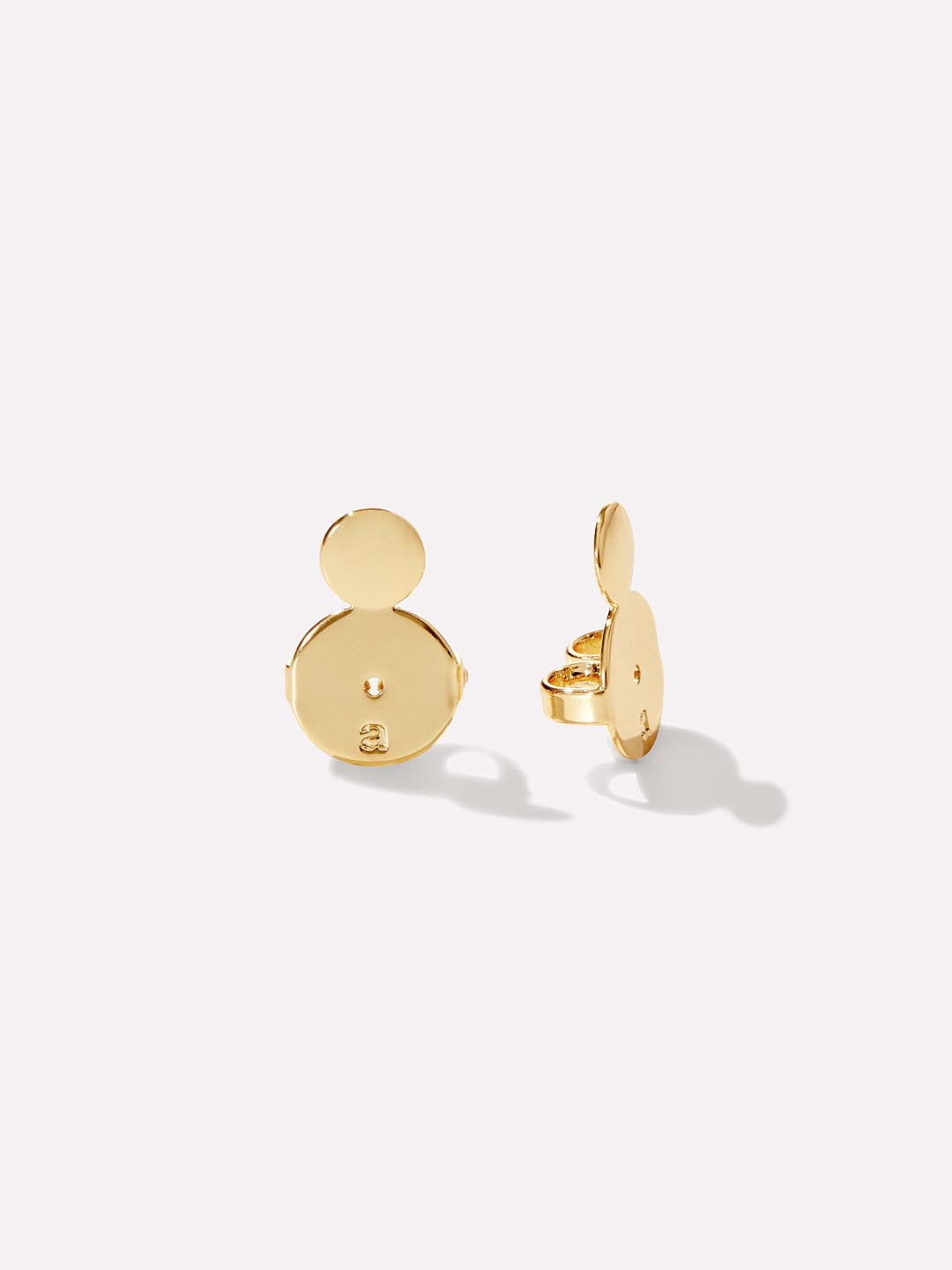
1. Butterfly Backs (Friction Backs) – The Most Common
Design: Small, metal discs with two flexible "wings" that grip the earring post via friction. They slide onto the post and stay in place with pressure.
Best For: Lightweight earrings (studs, small hoops) with thin posts (0.7–1mm). They’re the default back for most costume jewelry and affordable fine jewelry.
Pros:
-
Easy to put on/take off (great for kids or anyone with limited dexterity).
-
Inexpensive (replaceable if lost).
Cons: -
Not secure for heavy earrings (they can slip off with movement).
-
Friction wears down over time (needs replacing every 6–12 months).
-
Can pinch skin if the wings are too tight.
Pro Tip: Use butterfly backs for casual, lightweight earrings—but upgrade to a more secure style for valuable pieces (e.g., diamond studs).
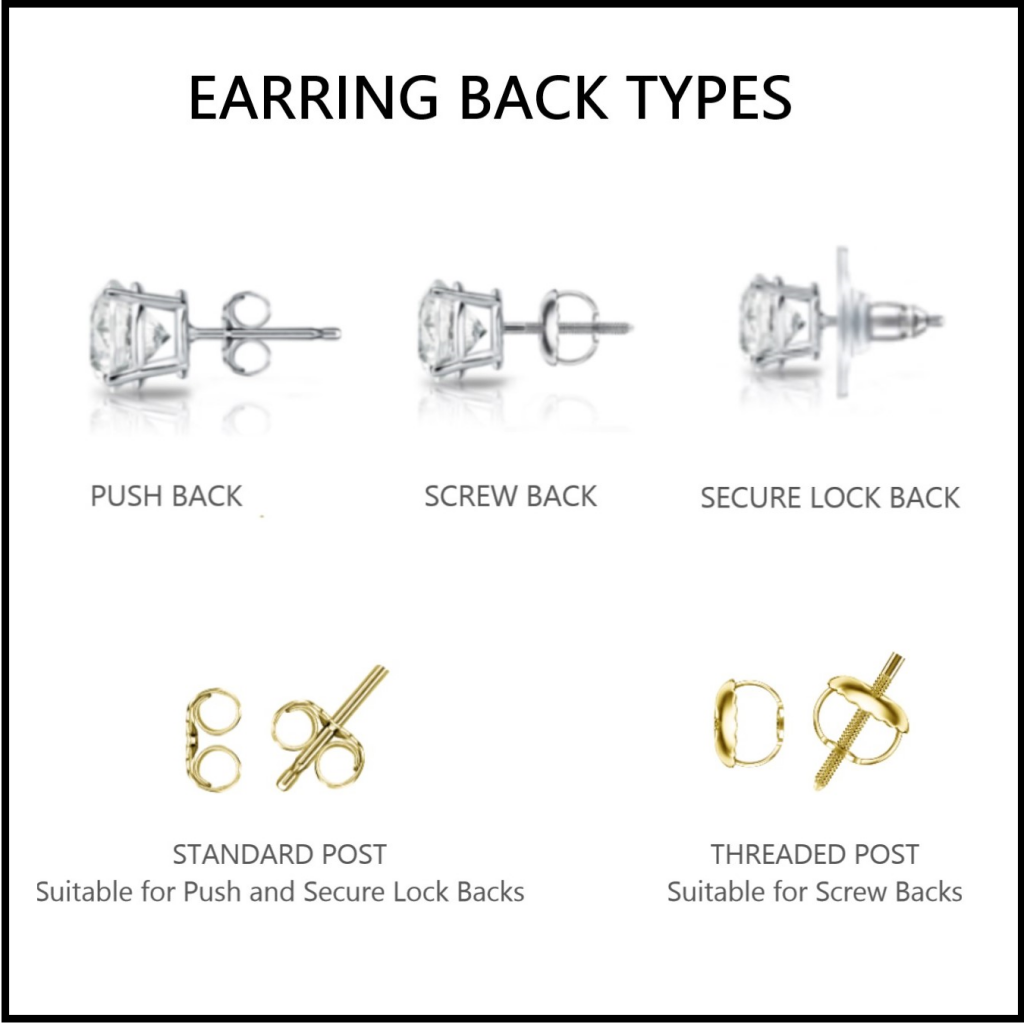
2. Screw Backs (Threaded Backs) – The Most Secure
Design: Metal backs with internal threads that screw onto a threaded earring post (the post has tiny grooves). They lock into place, so they won’t slip off accidentally.
Best For: Valuable earrings (diamonds, gemstones), heavy earrings (drop, chandelier), or anyone prone to losing earrings (active people, kids).
Pros:
-
Ultra-secure—ideal for everyday wear or travel (no lost earrings!).
-
Durable (lasts for years with proper care).
-
Even pressure on the earlobe (less discomfort than butterfly backs).
Cons: -
Take longer to put on/take off (requires twisting).
-
More expensive than butterfly backs.
-
Only works with threaded posts (won’t fit standard smooth posts).
Pro Tip: Screw backs are worth the investment for heirloom earrings—they’ll protect your piece for decades.
3. Latch Backs (Hinged Backs) – For Hoops & Dangles
Design: Hinged metal backs that "snap" into place on a small notch at the end of a hoop or dangle earring post. Common on huggie hoops and medium-weight drop earrings.
Best For: Hoop earrings (huggies, medium-sized hoops) and dangle earrings with a curved post.
Pros:
-
Secure and easy to use (one-handed application for most styles).
-
Holds hoops in place without sagging.
-
Smooth design (no pinching or catching).
Cons: -
Hinge can wear out over time (may need professional repair).
-
Not ideal for very heavy earrings (hinge may loosen).
Pro Tip: Choose latch backs with a sturdy hinge (look for thick metal) for long-lasting use.

4. Push-Back Flat Backs (Labret Backs) – For Comfort & Discretion
Design: Small, flat metal discs that push onto a smooth post (some have a tiny rubber O-ring for extra grip). They sit flush against the earlobe—no protruding parts.
Best For: Sensitive skin, everyday wear, or earrings worn while sleeping (no poking!). Also popular for newly pierced ears (gentle on healing skin).
Pros:
-
Ultra-comfortable (no digging into the back of the earlobe).
-
Discreet (no bulky backs visible from behind).
-
Hypoallergenic options available (titanium, surgical steel).
Cons: -
Less secure than screw backs (can slip if the post is too thin).
-
May need to be replaced if the O-ring wears out.
Pro Tip: Use push-back flat backs for newly pierced ears—they reduce irritation and let the piercing heal evenly.
5. Rubber Backs (Silicone Backs) – Budget-Friendly & Gentle
Design: Soft, flexible backs made of rubber or silicone that slide onto smooth posts. They grip the post via friction and are often used as "backup" backs.

Best For: Lightweight costume jewelry, kids’ earrings, or anyone with sensitive skin (rubber won’t irritate like metal).
Pros:
-
Cheap (packs of 10–20 cost $5–$10).
-
Gentle on skin (no metal allergies).
-
Easy to replace (keep extras in your jewelry box).
Cons: -
Not secure for heavy or valuable earrings (rubber stretches over time).
-
Can collect dirt and oil (needs regular cleaning).
-
Not durable (lasts 3–6 months with daily use).
Pro Tip: Use rubber backs as a temporary fix for lost butterfly backs—or pair them with metal backs for extra security (double up!).
6. Locking Backs (Safety Backs) – For Maximum Security
Design: Advanced backs with a two-step locking mechanism (e.g., push and twist, or snap-and-lock) that prevents accidental removal. They’re often used in medical settings or for expensive jewelry.
Best For: Very heavy earrings (chandelier, statement pieces), active lifestyles (gym, sports), or anyone who’s lost earrings frequently.
Pros:
-
The most secure option—virtually impossible to slip off.
-
Durable (made of high-quality metal like stainless steel or titanium).
Cons: -
Most expensive (cost $15–$30 per pair).
-
Can be tricky to put on at first (requires practice).
Pro Tip: Locking backs are a game-changer for travelers—no worrying about earrings falling off in hotel rooms or on planes!
How to Choose the Right Earring Back (Step-by-Step Guide)
Choosing the right earring back depends on your earring type, lifestyle, and comfort needs. Follow these steps to avoid mistakes:
Step 1: Match the Back to Your Earring Type & Weight
-
Lightweight Studs (≤0.5ctw): Butterfly backs or rubber backs work fine.
-
Valuable Studs (diamonds, gemstones): Screw backs or locking backs (protect your investment).
-
Hoops (huggies, medium-sized): Latch backs (secure and easy to use).
-
Heavy Drop/Dangle Earrings: Screw backs or locking backs (prevent sagging and loss).
-
Newly Pierced Ears: Push-back flat backs (titanium or surgical steel—gentle on healing skin).
Step 2: Consider Your Lifestyle
-
Active (Gym, Sports, Outdoor Work): Screw backs or locking backs (no slipping during movement).
-
Sensitive Skin: Push-back flat backs (titanium/surgical steel) or rubber backs (avoid nickel in metal backs).
-
Frequent Travel: Screw backs or locking backs (no lost earrings in transit).
-
Kids/Elderly: Butterfly backs or rubber backs (easy to handle).
Step 3: Check Post Compatibility
Not all backs fit all posts—measure your earring post’s thickness (use a ruler or jewelry gauge) to ensure a snug fit:
-
Butterfly/Rubber Backs: Fit posts 0.7–1mm thick.
-
Screw Backs: Require threaded posts (look for tiny grooves on the post).
-
Latch Backs: Fit posts with a small notch (common on hoops).
Step 4: Test for Comfort
Before committing to a back, wear it for 1–2 hours:
-
Does it pinch or dig into your earlobe?
-
Is it easy to put on/take off by yourself?
-
Does the earring stay upright (no tilting)?
If it’s uncomfortable or insecure, try a different style!
How to Prevent Lost Earrings (Pro Tips for Secure Wear)
Even the best earring backs can’t prevent loss if you don’t use them correctly. Follow these hacks to keep your earrings safe:
1. Always Check the Back Before Wearing
-
Tug gently on the earring after putting it on—if the back wiggles, it’s too loose (replace it or tighten it).
-
For screw backs: Twist until it’s snug, but not so tight that it hurts (you should be able to slide a finger between the back and your earlobe).
2. Keep Spare Backs Handy
-
Store a pack of butterfly, rubber, or push-back backs in your jewelry box, purse, and travel bag.
-
Label extras by type (e.g., "screw backs for diamond studs") to avoid mixing them up.
3. Remove Earrings Carefully
-
Don’t yank earrings off—slide or unscrew the back first to avoid stretching the post or breaking the back.
-
For latch backs: Press the hinge to release it gently (don’t pull the hoop directly).
4. Clean Backs Regularly
-
Dirt, oil, and lotion can make backs slippery—clean them weekly with warm soapy water (metal backs) or mild soap (rubber backs).
-
Dry thoroughly before reusing (moisture can cause metal backs to tarnish).
5. Use "Double Security" for Valuable Earrings
-
Pair a butterfly back with a rubber back (slide the rubber back onto the post first, then the butterfly back) for extra grip.
-
For screw backs: Add a tiny dot of clear nail polish to the threads (let it dry first!) to prevent loosening (works for costume jewelry—avoid on fine metals).
How to Care for Earring Backs (Make Them Last)
Proper care extends the life of your earring backs and keeps them secure:
For Metal Backs (Butterfly, Screw, Latch, Push-Back)
-
Clean Weekly: Soak in warm water with a drop of mild dish soap for 5 minutes.
-
Scrub Gently: Use a soft-bristled toothbrush to remove dirt from crevices (e.g., the wings of butterfly backs, the threads of screw backs).
-
Tarnish Removal: For silver or brass backs, polish with a jewelry cloth (avoid using on gold-plated backs—polishing can wear off the plating).
-
Store Separately: Keep metal backs in a small container or jewelry pouch to prevent scratching or tangling with other jewelry.
For Rubber/Silicone Backs
-
Clean Biweekly: Wipe with a damp cloth dipped in mild soap—avoid soaking (rubber can absorb water and stretch).
-
Replace Every 3–6 Months: Rubber breaks down over time (especially with exposure to oil and heat)—don’t wait until it snaps or slips.
-
Store in a Cool Place: Keep away from direct sunlight or heat (e.g., a hot car)—heat can melt or warp rubber.
Frequently Asked Questions About Earring Backs
Q1: My earring back is stuck on the post—how do I get it off?
A: Don’t pull! For metal backs: Dip a cotton swab in baby oil or olive oil and rub it around the post (oil loosens friction). For screw backs: Use a pair of tweezers (wrap the tips in tissue to avoid scratching) to grip the back and twist gently.
Q2: Can I use any earring back with any earring?
A: No—match the back to the post type and earring weight. For example, screw backs only work with threaded posts, and butterfly backs won’t hold heavy drop earrings.
Q3: Are there hypoallergenic earring backs?
A: Yes! Look for backs made of titanium, surgical steel, or nickel-free brass (great for sensitive skin). Rubber/silicone backs are also hypoallergenic.
Q4: How do I know if an earring back is too tight?
A: If your earlobe turns red, feels numb, or hurts after wearing earrings for an hour, the back is too tight. Loosen it slightly (for screw backs) or replace it with a larger size (for butterfly backs).
Q5: Where can I buy replacement earring backs?
A: You can find them at jewelry stores (local or chain stores like Claire’s), craft stores (Michaels, Joann), or online (Amazon, Etsy, jewelry supply sites like Fire Mountain Gems). Look for packs labeled by type (e.g., "screw backs for 1mm posts") to ensure a fit.
Conclusion: Don’t Overlook the Back—It’s Make or Break for Your Earrings
Earring backs may be small, but they’re the difference between enjoying your favorite earrings and losing them to a couch cushion or a busy day. By choosing the right style for your earrings and lifestyle, caring for them properly, and using simple security hacks, you can keep your earrings safe, comfortable, and looking great for years.
Next time you shop for earrings, don’t just focus on the front—ask about the back! Whether you need a secure screw back for diamond studs, a comfortable flat back for sensitive skin, or a budget-friendly rubber back for costume jewelry, the right earring back will make every wear a worry-free experience.
Here’s to secure, comfortable earrings—one great back at a time!


